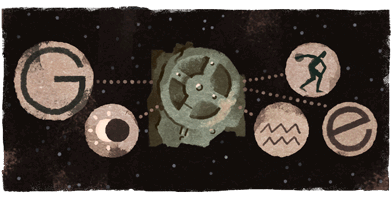Today's Google Doodle: 115th Anniversary Of The Discovery Of Ancient Antikythera Mechanism

When sponge divers discovered the Antikythera shipwreck in 1900, they neglected the Antikythera mechanism. Two years later Greek archeologist Valerio Stais discovered the pieces of plates and gears all made up a single device. But researchers had no idea what it was. In fact, nobody knew what it was for decades. Pieces of the mechanism sat under the ocean for 2,000 years and ended up broken and discolored, making them more difficult to identify.
Read: Bones Of Two Human Sacrifices Found In Ancient South Korea Kingdom’s Palace
Now 115 years after its discovery the primitive computer is gracing the homepages of computers around the world as the Google Doodle of the day Wednesday. The mechanism is in the center of the Google logo on the search page. It looks like a green circular outer rim with four prongs.
X-ray imaging late in the 20th century brought scholars to the conclusion the device may have been used for timekeeping, on a celestial clock. It took researchers years to discover the 87 pieces of the mechanism that has gears that once predicted astrological events and kept the zodiacal and solar calendars.
The pieces of the mechanism were pulled from a shipwreck off the coast of Antikythera island, a small island between the coasts of the Greek mainland and the island of Crete. The wreck has been the site of many dives since its discovery because of the valuable ancient artifacts found there. Statues, glassware, ceramic jugs, a skeleton and, of course, the mechanism were found underwater amid the wreckage. Research done on the ship itself have led researchers to believe it was a Roman vessel carrying Greek artifacts, many of which date to decades earlier. The ship is estimated to have crashed 70-60 B.C.
The wreck has been studied since it was discovered and the mechanism was originally thought to be from 85 B.C., but a study later showed it may actually be older, possibly 150 B.C. It's currently on display at the National Archeological Museum of Greece.
Read: Scientists Use Skull And Bones To Recreate Ancient Woman’s Face
The mechanism contained gearwheels, dials, scales and axles. forming a sophisticated tool that was advanced for its time. The inscriptions on the mechanism's protective plates provide instructions for use, the museum said. Researchers said pieces of wood found with the mechanism were part of a protective box in which the mechanism was kept, with bronze plates on the front and back for protection. It's referred to as a primitive computer because it's the earliest known astronomical calculator. It most likely predicted the positions of the sun and moon and eclipses of both, as well as providing an accurate calendar of the years and Olympic games.
What's left of the wreck sits under 180 feet of water in an area of the sea notorious for its storms. But that hasn't stopped divers and researchers from further studying the remnants. Jacques Cousteau even led an expedition to the site in 1976.

© Copyright IBTimes 2024. All rights reserved.




















